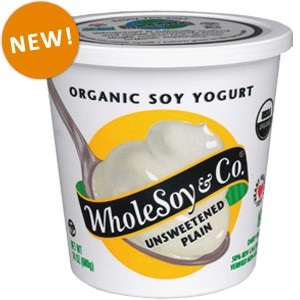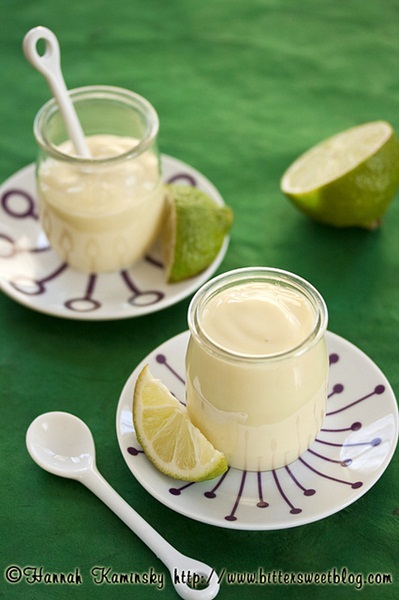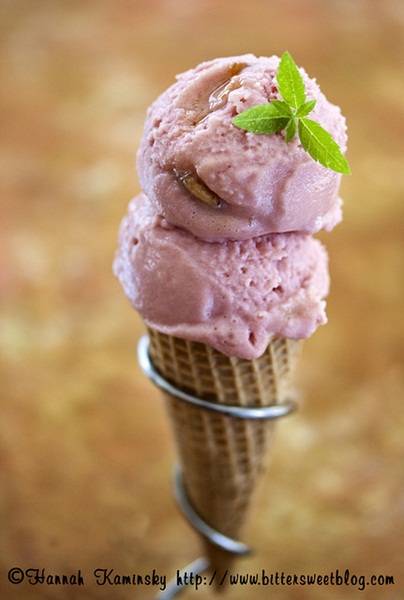WholeSoy & Co unfortunately closed their doors in 2015 after longtime manufacturing woes. Made with whole organic soy, with a creamy finish and delicious flavors, WholeSoy Yogurt will be greatly missed in the dairy-free world. If you are looking for soy yogurt, Silk Soymilk Yogurt and Stonyfield Organic Dairy Free Yogurt are still available.
 WholeSoy & Co. has released new Key Lime and Unsweetened varieties, adding to their already popular line of dairy-free yogurts. Though I’ve heard the new Key Lime flavor is wonderful, what excited me most was the idea of an unsweetened vegan yogurt. There is only one other brand on the market, and it’s always been difficult if not impossible for me to find. But now that WholeSoy & Co. is on the scene with an unsweetened version, I’m sure consumer demand will help it pop into stores quickly.
WholeSoy & Co. has released new Key Lime and Unsweetened varieties, adding to their already popular line of dairy-free yogurts. Though I’ve heard the new Key Lime flavor is wonderful, what excited me most was the idea of an unsweetened vegan yogurt. There is only one other brand on the market, and it’s always been difficult if not impossible for me to find. But now that WholeSoy & Co. is on the scene with an unsweetened version, I’m sure consumer demand will help it pop into stores quickly.
Some of you may be wondering why it is so uncommon to see unsweetened, dairy-free yogurt. To help the cultures grow in yogurt you need a carbohydrate, a sugar if you will. Dairy has loads of natural sugars, in the form of lactose, so dairy-based yogurts can be made fairly easily without any added sweeteners. Take a look; even those “uber-healthy” unsweetened Greek yogurts have some sugars on the nutrition label. Unfortunately, the base foods that are used to make dairy-free yogurts (such as soy or coconut) are not as rich in natural sugars as milk. Sweetener is typically added as some type of carbohydrate is needed to spur that healthy bacteria growth along … that is until WholeSoy & Co. invented a way around this issue:
“Dr. Ted A. Nordquist, founder and CEO of WholeSoy & Co., worked with a team, including Dr. Luba Shynkarenko-Sichel of Pure Research Products, to create WholeSoy’s Organic Unsweetened Plain soy yogurt. Dr. Shynkarenko-Sichel developed a unique strain of probiotic culture, L. Plantarum LM, over many years of research in Ukraine. WholeSoy’s new Organic Unsweetened Plain soy yogurt is the first non-dairy unsweetened yogurt to use the L. Plantarum LM culture.
The culture favors soy so much that at production it develops 140 billion CFUs (Colony Forming Units) per 8-ounce serving together with the other probiotic cultures, L. Acidophilus and B. Bifidum. This breakthrough eliminated the need for the addition of other carbohydrates, such as organic sugar, to aid the development of probiotic cultures. The result of this new development is a protein rich non-dairy soy yogurt with as much protein as a dairy yogurt and all the digestive and immune building benefits of the probiotic cultures without the added sugar.”
One of our Go Dairy Free reviewers, Hannah Kaminsky (author of My Sweet Vegan), had the opportunity to preview these new WholeSoy varieties, and here is what she thought:
Key Lime – “Happy to discover a mellow, warm shade of yellow beneath the lid and not artificial, florescent green, things certainly looked promising. Accustomed to highly sugared, pudding-like renditions, I was surprised at first to be met with such a tart, acidic flavor. Intense but in a good, “wake you up” sort of way, the lime flavor was very much present, bright and punchy, but still well balanced by just the right level of sweetness. The thick, rich mouth feel was almost like custard, and mercifully never approached the line of gummy or slimy. Once available nationwide, I know this flavor will be making more appearances in my meals!”

Unsweetened – “Surprisingly few options for such a simple variety exist, and this blank canvas can open the door to all sorts of cooking and baking applications, from sweet to savory and all things in between. Without the vaguest hint of sweetness and a very tangy finish, it has almost a cheesy flavor. Thoroughly drained and pressed, I can easily see it becoming a delicious farmer’s cheese type of spread! I couldn’t wait long enough to find out, but after two days sitting in cheesecloth, it did thicken up nicely to create… frozen yogurt!”

Some may not know this, because distribution never made it into full swing, but WholeSoy & Co. used to produce the most amazing frozen yogurt. The idea of making this at home is simply wonderful. You can see Hannah’s full review and the recipe for her Blood Orange Frozen Yogurt pictured above on her blog, Bittersweet.

10 Comments
The coconut cream yogurt and silken tofu yogurt say 1:1 ratio. 1:1 ration with what as the second ingredient? I understand the coconut cream and the tofu but what is the second thing you mix with?
Thank you!
Hi Darla, are you referring to a recipe? I’m not sure what your comment is inquiring on since this is a review post.
Hi… Ur web page is very informative….
I want to know about butter oil…
Is butter oil (made of dairy butter) lactose freeor not…/
Yes, butter oil is derived from butter.
Which probiotic cap do u recommend as a starter?
Do u need to add a suagr source to plain soymilk for making yogurt (or do the bacteria feed on the fiber in the soymilk)?
I like ther-biotic complete powder. Yes, because there is no lactose (milk sugar), you will typically need to add something that the bacteria can feed off of if making it at home. I’m not sure how WholeSoy makes their version unsweetened, but plan to look into it.
Hi! I’m doing an investigation for my chemical engineering degree, about non-dairy yogurts. I see you mentioned above a ” No Dairy Product List”, and I wold love to have that information (specifically about yogurts). Would you please tell me where can I find it? Thanks a lot!
Erika, you can find more information here – http://www.godairyfree.org/no-dairy-product-lists.
my boyfriend is vegan and I want to join in the fun, but I am a big dairy fan: Cheese,yogurt, milk, etc. and don’t know where to start…I want to be able to make everything at home, can you please let me know if it’s possible to make dairy-free yogurt at home with a yogurt maker? Thanks in advance for your time and kindness!
Hi Olivia, definitely! See the page on yogurt subs – http://www.godairyfree.org/dairy-substitutes/how-to-substitute-yogurt.
You might also find these pages helpful too:
Dairy Subs – http://www.godairyfree.org/dairy-substitutes
Where to Start – http://www.godairyfree.org/dairy-free-information/new-to-the-dairy-free-diet-start-here